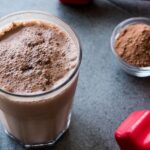
How To Get Rid Of Lactic Acid – A Complete Guide
Page Contents
You’ve undoubtedly experienced the intense muscular burn that frequently results from engaging in weight training, high-intensity interval training, or other rigorous exercises. As well as muscle soreness 2-3 days after an intense training session. Lactic acid accumulation is commonly blamed for these burning sensations, and most people wish to get rid of lactic acid.
I am sure your dad or coach has told you that you need to get rid of lactic acid to recover properly. Both recreational and competitive athletes have long believed that reducing the amount of lactic acid in their systems will improve performance. However, this idea is not exactly true.
So what is lactic acid? What causes lactic acid buildup? What are the 3 symptoms of lactic acid buildup? How do you get rid of lactic acid? Continue reading to find out.
What Is Lactic Acid?
One of the metabolic processes the body employs to make energy during vigorous exercise is glycolysis, which produces lactic acid as a byproduct. The by-products of this process, lactate and hydrogen ions, are together referred to as lactic acid.
Although lactate is a sign of exhaustion and glucose breakdown, muscular fatigue is not really brought on by lactate. In reality, lactate is a crucial component of cellular functions and is the preferred source of energy for several organs, including the heart and brain. Through a process known as gluconeogenesis, your liver and kidneys may also transform lactate into glucose, enabling your body to utilize glucose for energy.
The circulating hydrogen ions left behind in your cells, which produce an acidic environment, together with phosphates, are what cause the burn you experience after pushing yourself during rigorous exercises. So when you are looking to get rid of lactic acid your actually trying to lower the acidity of your blood.
Although the immediate burn experienced following heavy sets is caused by a reduction in cellular pH, delayed onset muscle soreness (DOMS), which frequently follows vigorous exercise, is not caused by lactic acid. Localized micro-injury to muscle fibers along with inflammation are likely the causes of DOMS.
What Causes Lactic Acid Buildup?
When you engage in high-intensity exercise, your body works hard to provide the energy required to keep up the activity, which results in the production of lactic acid. Adenosine triphosphate (ATP) is the main energy source for our body.
The body used three energy systems; the ATP-PC system, the glycolytic system, and the oxidative system.
The body relies on the ATP-PC and Glycolytic systems (glycolysis) for immediate energy during bouts of high-intensity activity, such as sprints or heavy weight training, because they make ATP at higher rates than the latter system. Because the ATP-PC system makes ATP the quickest, the body will consume it first. The body then switches to the glycolytic system, also known as glycolysis, when the ATP-PC system’s energy reserves begin to deplete. A byproduct of glycolysis is pyruvate, which is created throughout the process. The pyruvate is broken down and converted into additional ATP to be utilized as energy when there is a sufficient amount of oxygen present in the cells.
The issue arises, though, when the body is unable to provide oxygen to the cells quickly enough, leading to an environment in the cell that is anaerobic (lacking oxygen). This causes pyruvate to build up in the muscle cell, where it is swiftly transformed into lactate while simultaneously releasing a free hydrogen ion.
After the lactic acid is eliminated from the muscle cell, the hydrogen ion and lactate reside in the bloodstream independently. It’s not so much the lactic acid buildup in the muscles that causes a problem as it is the hydrogen ions and lactate buildup in the blood, which can eventually affect performance.
When there is an excess of these substances in the blood, it may become acidic, which might harm the body’s other organs and systems. The abundance of lactate and hydrogen ions that are accumulated in the blood during vigorous exercise may fortunately be managed by the body in a number of ways allowing the body to get rid of lactic acid (lactate + hydrogen ion).
What Are 3 Symptoms Of Lactic Acid Buildup?
One of the symptoms of lactic acid buildup is a burning sensation in your muscles.
A reduction in pH and a more acidic environment in your muscle cells as a result of reaching your lactate threshold, causing your body to produce excessive amounts of lactate and release hydrogen ions and resulting in a burning sensation.
Another symptom is heavy breathing or shortness of breath. As I said prior, this energy system that your body uses requires oxygen to function properly, and while you heavily exert your body you will go into an anaerobic state causing heavy breathing or shortness of breath.
Nausea could also be another symptom of lactic buildup.
How To Get Rid Of Lactic Acid?
The body can control the surplus lactate in the blood by turning it back to energy in a process known as the Cori Cycle, whether at rest or during steady-state exercise. The blood includes a number of buffers to assist in normalizing the pH level that is threatened by the acidity of the hydrogen ions.
Thankfully, we don’t need to be concerned about lactic acid accumulation. There’s no need to get rid of lactic acid. This metabolic by-product may be handled by the human body as soon as it reaches the bloodstream.
One thing you can do is increase your lactate threshold. The lactate threshold is your body’s ability to tolerate lactate and hydrogen ion buildup.
The moment your lactate threshold is crossed, the timer on how long you can maintain that effort starts to run out. Conversely, you may maintain energy for a very long time when you exercise below the lactate threshold.
Your lactate threshold may be raised by training your body to work at higher intensities without producing more lactate. To do this, though, you must increase the effectiveness of your aerobic system.
Although this does not prevent the accumulation of lactate, it does allow you to run farther and faster before experiencing muscle burn.


